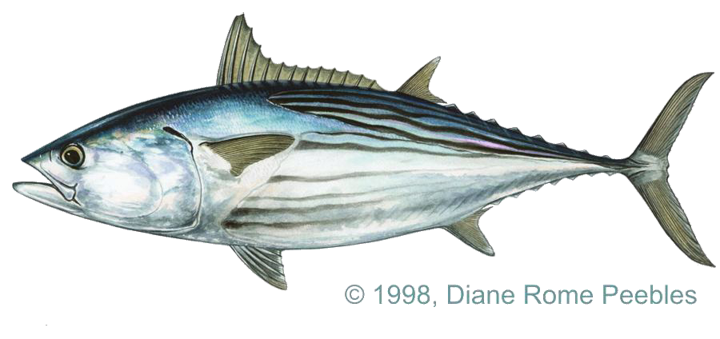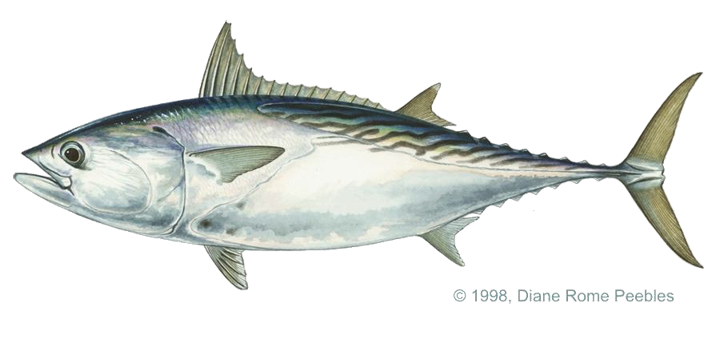Game Fish Identification Reference Guides
Skipjack, black
(Euthynnus lineatus)
(Euthynnus lineatus)

Kishinouye, 1920; SCOMBRIDAE FAMILY; also called little tuna, false albacore, spotted tuna, mackerel tuna, skipjack
They inhabit tropical and warm temperate waters of the eastern Pacific Ocean from California to Peru, and rarely the central Pacific.
The dorsal fin has 13 15 spines and is high anteriorly. This distinguishes it from the bonito, Sarda, which have a relatively long and low first dorsal fin. The anal fin, which has 11 13 rays is similar to the second dorsal fin in size and shape. The body lacks scales, except on the anterior corselet and along the lateral line. This is the only species of Euthynnus with 37, instead of the usual 39, vertebrae. Each jaw has 20 40 small, conical teeth. Bonitos have fewer and larger conical teeth. Mackerels have flat, triangular teeth.
It is distinguished from similar species by the 4 or 5 broad, straight, black stripes which run horizontally along the back and by the dark spots between the pectoral and ventral fins. In live specimens, stripes may be visible on the venter as well as on the back, which has frequently led to confusion with the skipjack tuna, Katsuwonus pelamis. The stripes on the belly rarely persist long after death in the black skipjack, however, whereas they remain prominent in the skipjack tuna.
It is pelagic, schooling and migratory, feeding predominantly on small surface fishes, squids, and crustaceans. It can be hooked by trolling or casting small whole baits or strip baits, or small lures such as spoons, plugs, jigs, and feathers. It has been said that the black skipjack will strike any lure trolled at speeds up to 8 or 10 miles per hour (12 16 km).
It is rated as a good food fish by some and disdained by others. Its flesh is dark red and the taste is strong
They inhabit tropical and warm temperate waters of the eastern Pacific Ocean from California to Peru, and rarely the central Pacific.
The dorsal fin has 13 15 spines and is high anteriorly. This distinguishes it from the bonito, Sarda, which have a relatively long and low first dorsal fin. The anal fin, which has 11 13 rays is similar to the second dorsal fin in size and shape. The body lacks scales, except on the anterior corselet and along the lateral line. This is the only species of Euthynnus with 37, instead of the usual 39, vertebrae. Each jaw has 20 40 small, conical teeth. Bonitos have fewer and larger conical teeth. Mackerels have flat, triangular teeth.
It is distinguished from similar species by the 4 or 5 broad, straight, black stripes which run horizontally along the back and by the dark spots between the pectoral and ventral fins. In live specimens, stripes may be visible on the venter as well as on the back, which has frequently led to confusion with the skipjack tuna, Katsuwonus pelamis. The stripes on the belly rarely persist long after death in the black skipjack, however, whereas they remain prominent in the skipjack tuna.
It is pelagic, schooling and migratory, feeding predominantly on small surface fishes, squids, and crustaceans. It can be hooked by trolling or casting small whole baits or strip baits, or small lures such as spoons, plugs, jigs, and feathers. It has been said that the black skipjack will strike any lure trolled at speeds up to 8 or 10 miles per hour (12 16 km).
It is rated as a good food fish by some and disdained by others. Its flesh is dark red and the taste is strong














